
Poker is a card game played against other players. To win, you must have two distinct pairs of cards, plus a fifth card. The highest pair wins. In a tie, the second-highest pair wins. Similarly, the high card breaks ties when no one has a pair. It also breaks ties when several people have high hands of the same type.
The rules of poker
A game of poker is a social game played by two or more people. The rules of poker differ from one variation to another, but they generally follow the same rules. The players wager the same amount of money at the beginning of the hand, and they are not allowed to add more wagers until the hand plays out.
Variants of poker
Poker comes in many variants, all of which follow a similar pattern of play. While most poker players tend to have a favorite version of the game, some prefer to branch out and try out different variants. One of these is stud poker.
Hand rankings
Knowing the hand rankings in poker can be an extremely valuable tool for your game. It can improve your strategy and win you more money. Knowing how high your hands should rank can also help you calculate the odds of winning a pot, and it can help you make better decisions.
Betting intervals
Betting intervals are intervals in a poker game where the players put their money into the pot in an effort to increase their chances of winning. They make decisions based on various factors, including game theory, probability, and psychology. This article explains betting intervals and how they work.
Combos
In poker, hand combinations are an important part of the game. Flushes are extremely difficult to beat and are a great way to win a pot. It’s important to learn the odds of these combinations so you can make the best bet for your hand. To learn the odds of a combination occurring in your hand, use a hand matrix program.
Stakes in poker
The word “stakes” in poker has a variety of meanings and varies according to the level of skill of the player. Stakes can refer to specific amounts of money, low, medium, or high. They can also refer to the size of the blinds. For example, a $1 million buy-in cash game could have a $500/$1000 blind structure.